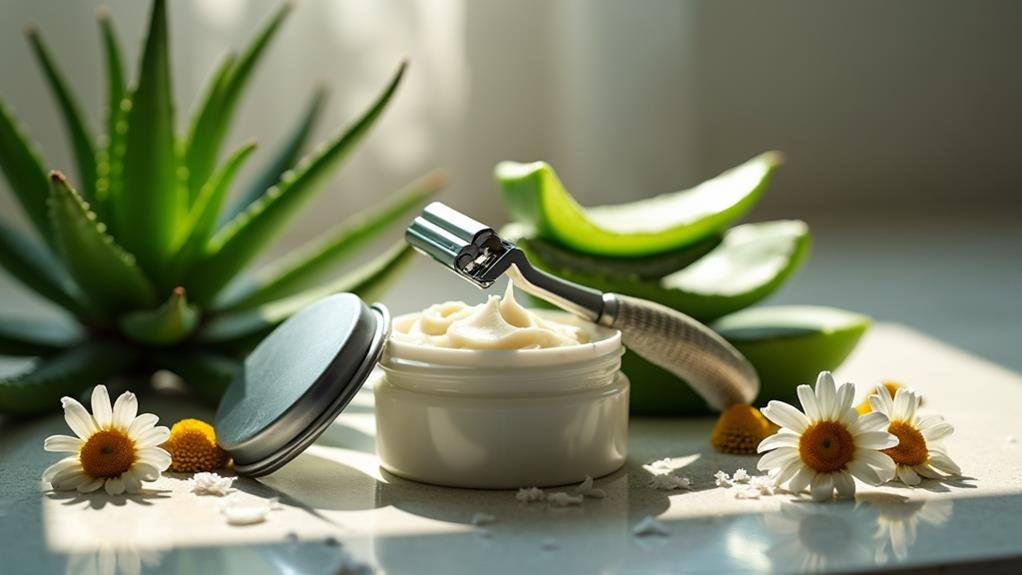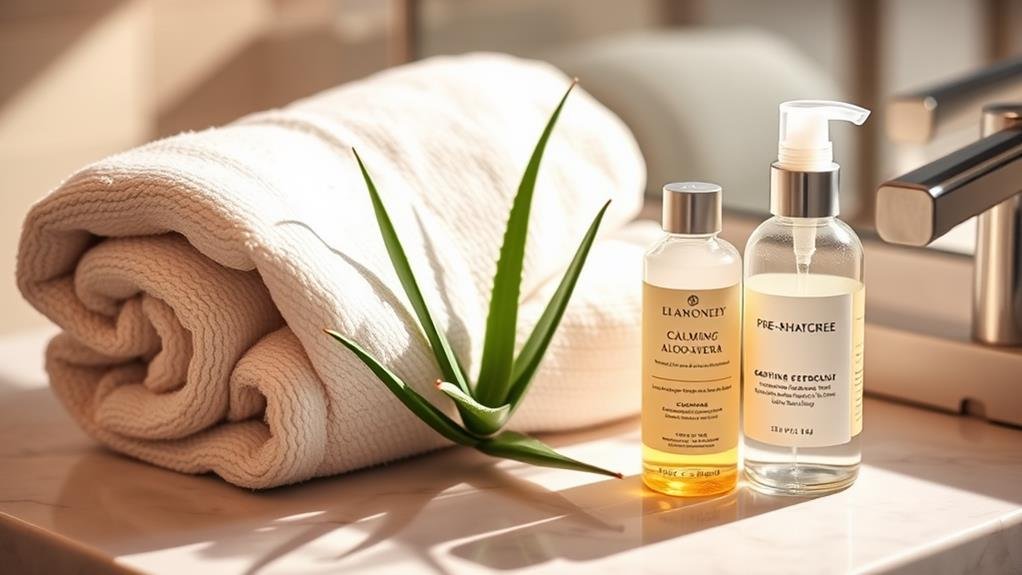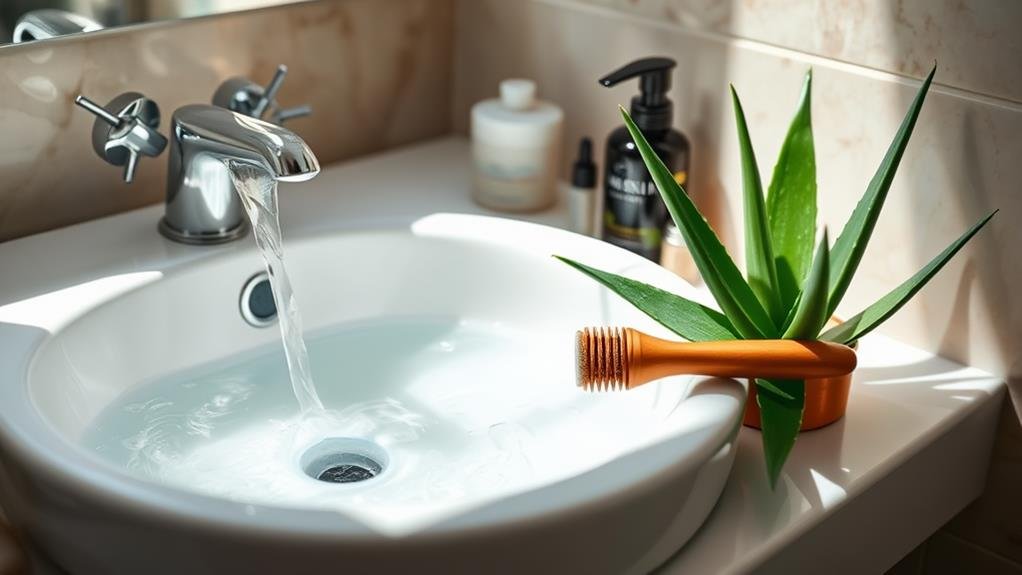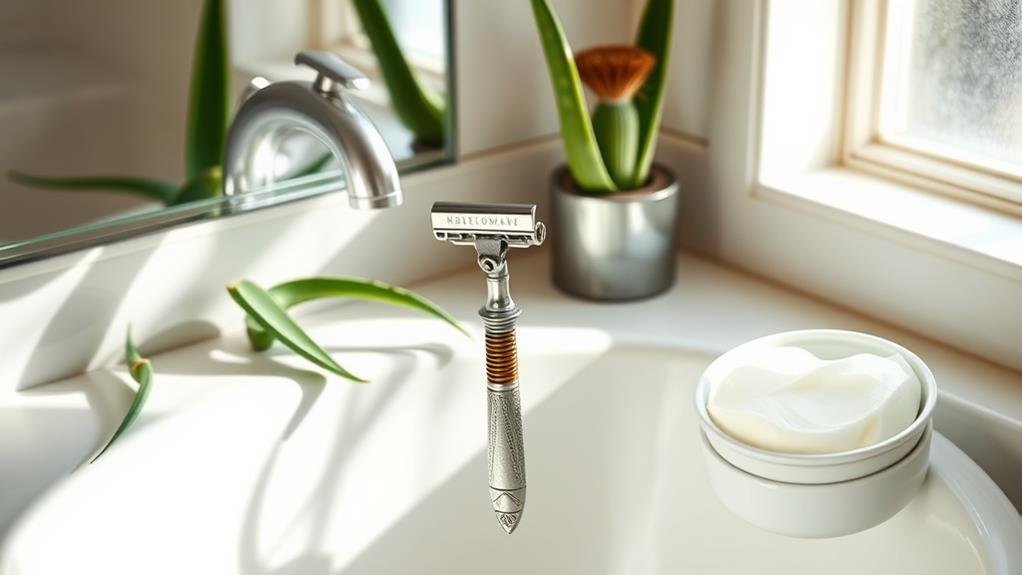
For gentle shaving on sensitive skin, choose a sharp razor and opt for fewer blades to reduce tugging. Prepare your skin by cleansing, exfoliating, and applying a warm towel before using a moisturizing, fragrance-free shaving cream. Always shave in the direction of hair growth, applying light pressure and avoiding multiple passes over the same area to minimize irritation. After shaving, rinse with cool water to close pores and follow up with a soothing moisturizer. Lastly, limit your shaving frequency to allow your skin time to recover. There's more to explore for optimal comfort and care.
Key Takeaways
- Choose a single-blade cartridge or electric razor to minimize tugging and reduce irritation on sensitive skin.
- Use shaving creams with natural, fragrance-free ingredients to soothe and hydrate skin during shaving.
- Always shave in the direction of hair growth and maintain a light pressure to avoid nicks and irritation.
- Rinse with cool water post-shave to calm skin and apply a gentle moisturizer with soothing ingredients like aloe vera.
- Allow adequate time between shaves to promote skin recovery and assess reactions to products used.
Understand Your Skin Type

Understanding your skin type is crucial for effective shaving, especially if you have sensitive skin. You need to recognize the skin sensitivity factors specific to you, as this knowledge can significantly impact your shaving experience.
Start by examining how your skin reacts to various products and environmental conditions. Identifying irritants is essential; common culprits include fragrances, alcohol-based products, and certain shaving creams.
Perform a patch test with new products to see how your skin responds before applying them to larger areas. Pay attention to any redness, itching, or burning sensations, as these are indicators of irritation.
Also, consider your skin's moisture levels and natural oil production. Dry skin can exacerbate sensitivity, so hydrating before and after shaving is vital.
If you've had reactions in the past, keep a journal to track what products or techniques caused discomfort. This proactive approach will guide you in selecting suitable shaving methods and products tailored to your unique skin needs.
Ultimately, understanding your skin type empowers you to achieve a smoother, irritation-free shave, allowing you to embrace your freedom and confidence.
Choose the Right Razor
Choosing the right razor can make a significant difference in your shaving experience, particularly if you have sensitive skin. Start by considering the various razor types available.
Disposable razors are convenient but may lack the blade quality needed for a close, comfortable shave. Electric shavers offer an alternative that minimizes skin irritation, making them ideal for those with heightened skin sensitivity.
When comparing cartridge razors, look for options with fewer blades, as multiple blades can tug at the skin and cause discomfort. Safety razors are another excellent choice, providing a precise shave with the added benefit of being eco-friendly. They require proper razor maintenance but can save you money in the long run.
Regardless of the type you choose, ensure you focus on blade quality. Dull blades can lead to nicks and irritation, so always replace blades as needed.
With the right shaving tools and a thoughtful approach to your razor selection, you can enjoy a smoother, gentler shaving experience tailored to your sensitive skin needs.
Prep Your Skin Properly

Even with the right razor in hand, prepping your skin properly is key to achieving a comfortable shave. Start by cleansing your face with a gentle cleanser to remove dirt and oil. This step helps prevent irritation and allows for a smoother glide.
Next, exfoliate gently to slough off dead skin cells. This not only prevents clogged pores but also reduces the chance of ingrown hairs, ensuring a closer shave.
Once your skin is clean and exfoliated, it's crucial to hydrate your skin. Apply a warm, damp towel to your face for a few minutes to open up your pores. This will soften your facial hair and make it easier for the razor to cut through.
Afterward, use a good moisturizer or pre-shave oil to lock in moisture and create a protective barrier. This step is essential, especially for sensitive skin, as it helps minimize irritation during shaving.
Use a Gentle Shaving Cream
Selecting the right shaving cream is essential for a comfortable shave, especially if you have sensitive skin. A gentle shaving cream can make all the difference in reducing irritation and providing a smooth glide for your razor.
Look for products that feature natural ingredients, as these are less likely to cause adverse reactions.
Here are three key points to consider when choosing a shaving cream:
- Natural Ingredients: Opt for creams that include soothing components like aloe vera, chamomile, or shea butter. These ingredients can help calm your skin and prevent irritation during the shave.
- Fragrance-Free Options: Avoid creams with strong fragrances, as they can exacerbate sensitivity. Instead, choose fragrance-free options that prioritize your skin's health without unnecessary added scents.
- Moisturizing Properties: Select a cream that not only aids in shaving but also hydrates your skin. Look for formulations that lock in moisture, keeping your skin soft and supple.
Shave With the Grain

Shaving with the grain is a crucial technique for anyone with sensitive skin. When you shave in the direction of hair growth, you significantly reduce the chances of irritation, razor bumps, and ingrown hairs. To achieve this, you need to determine the natural direction of your hair growth. It can vary from one area of your face to another, so take a moment to assess it before you start.
Next, focus on maintaining the right blade angle. Holding your razor at about 30 degrees helps the blade glide smoothly over your skin, minimizing friction. This angle allows the blade to cut through hairs efficiently without tugging at them, making for a more comfortable shave.
Remember to use light pressure; let the weight of the razor do the work. Pressing too hard can lead to irritation, especially on sensitive skin.
Avoid Going Over the Same Area
To minimize skin irritation and reduce razor burn, it's crucial to avoid going over the same area multiple times.
Each pass can aggravate sensitive skin, leading to discomfort and inflammation.
Minimize Skin Irritation
Minimizing skin irritation during your grooming routine is essential for achieving a smooth finish, especially for those with sensitive skin.
One key approach to reducing irritation is to avoid going over the same area multiple times. This can lead to increased skin sensitivity and discomfort. By being mindful of your technique, you can enhance your shaving experience.
Here are three tips to help you minimize skin irritation:
- Use Sharp Shaving Tools: Dull blades can tug at your hair rather than cutting it cleanly. Ensure your shaving tools are sharp and in good condition to reduce irritation.
- Shave in the Direction of Hair Growth: Shaving against the grain can increase the likelihood of irritation. Follow the direction of hair growth to promote a smoother shave and limit discomfort.
- Don't Rush the Process: Take your time during your shaving routine. Rushing can cause you to press harder on your skin, resulting in irritation.
Reduce Razor Burn
Razor burn can be a frustrating consequence of an improper shaving technique, but you can significantly reduce its occurrence by avoiding repeated strokes over the same area.
When you shave, your skin needs time to recover. Going over the same spot repeatedly can irritate the skin, leading to discomfort and redness.
To minimize razor burn, focus on the direction of hair growth. Use gentle, even pressure with your razor, and try to make each stroke count.
If you find that you haven't achieved a close shave, consider reapplying your shaving cream instead of going over the area multiple times. This not only protects your skin but also ensures a smoother glide for your razor.
Additionally, consider using high-quality shaving products designed for sensitive skin.
Proper skin care before and after shaving can also aid in reducing irritation. Always hydrate your skin post-shave with a soothing balm or moisturizer to calm any potential redness.
Improve Shaving Efficiency
Achieving a close shave doesn't need to come at the expense of your skin's comfort. To improve shaving efficiency, focus on avoiding going over the same area multiple times. This not only enhances your shaving techniques but also minimizes irritation, especially if you have skin sensitivity.
Here are three essential tips to keep in mind:
- Prep Your Skin: Start with warm water and a quality shaving cream or gel. This softens the hair and opens up the pores, allowing for a smoother shave.
- Use the Right Tools: Invest in a sharp razor with multiple blades that moves easily over your skin. Dull blades require extra pressure, increasing the chance of nicks and irritation.
- Shave with the Grain: Always shave in the direction of hair growth. This reduces friction and prevents pulling on the skin, thus decreasing the likelihood of razor burn.
Rinse With Cool Water

Rinsing your skin with cool water after shaving offers several benefits, including reducing irritation and closing pores.
Make sure to time your rinse appropriately, ideally right after you've finished shaving.
Using a proper rinsing technique can further enhance your skin's comfort and health post-shave.
Benefits of Cool Rinse
Using cool water for your final rinse can significantly enhance your shaving experience, especially if you have sensitive skin. The cooling effects of a cool rinse help to calm irritation and reduce redness, leaving your skin feeling refreshed and revitalized.
Here are three key benefits you won't want to overlook:
- Reduced Irritation: The soothing sensations provided by cool water can alleviate any post-shave discomfort. This is crucial for sensitive skin, which is more prone to irritation from heat.
- Pore Tightening: Cool water helps to tighten your pores after shaving. This can minimize the chances of dirt and bacteria entering your skin, promoting healthier skin overall.
- Enhanced Comfort: The refreshing nature of a cool rinse not only feels great but also invigorates your skin. This can make the shaving process more enjoyable, allowing you to feel confident and comfortable throughout the day.
Incorporating a cool rinse into your routine is a simple yet effective way to ensure your sensitive skin stays calm and healthy.
Timing Your Rinse
Often, timing your rinse can make a significant difference in your shaving routine, especially for those with sensitive skin. After you finish shaving, it's essential to rinse your face with cool water. This isn't just a refreshing choice; the rinse temperature helps close your pores, reducing irritation and redness.
If you shave frequently, this step becomes even more crucial. The cooler water not only soothes your skin but also helps remove any leftover shaving cream or hair, ensuring your skin feels clean and comfortable. By timing your rinse right after shaving, you allow your skin to recover effectively from the friction and potential trauma caused by the razor.
To maximize the benefits, you might consider using a gentle, fragrance-free cleanser during your rinse. This can further enhance your post-shave routine without aggravating your skin.
Proper Rinsing Technique
A proper rinsing technique can significantly enhance your post-shave experience, especially for those with sensitive skin.
Rinsing with cool water helps close your pores, reducing irritation and promoting a soothing sensation. This simple step can make a remarkable difference in how your skin feels after using your favorite shaving tools.
Here are three tips for effective rinsing:
- Use Cool Water: After finishing your shave, switch to cool water. It helps calm your skin and minimizes inflammation caused by shaving.
- Gentle Motion: When rinsing, avoid aggressive scrubbing. Instead, gently splash cool water onto your face. This promotes skin exfoliation without causing further irritation.
- Follow with a Moisturizer: After rinsing, pat your skin dry and apply a gentle moisturizer. This step not only hydrates your skin but also locks in the post-shave comfort.
Moisturize After Shaving
Moisturizing after shaving is essential for maintaining healthy skin, especially for those with sensitive types. After you've gone through the shaving process, your skin needs a little extra care to soothe irritation and replenish lost moisture.
Choose post shave products that are specifically formulated for sensitive skin to avoid further irritation. Look for ingredients like aloe vera, chamomile, or hyaluronic acid, which provide gentle hydration.
The hydration importance can't be overstated; your skin may feel tight and dry after shaving, making it crucial to apply a moisturizer. This helps to restore your skin's natural barrier, preventing dryness and flakiness.
When selecting a moisturizer, opt for one that's fragrance-free and non-comedogenic to ensure it doesn't clog your pores or provoke sensitivity.
Applying your chosen moisturizer immediately after shaving locks in moisture and promotes quicker healing. A light, soothing balm or lotion is often ideal, as it absorbs quickly without leaving a greasy residue.
Limit Shaving Frequency

To maintain healthy skin, you should limit how often you shave.
An optimal shaving schedule allows your skin time to recover, reducing irritation and sensitivity.
Finding the right balance can lead to a more comfortable shaving experience overall.
Optimal Shaving Schedule
Finding the right shaving frequency can significantly impact your skin's health, especially if you have sensitive skin. By adjusting how often you shave, you can minimize irritation and allow your skin to recover.
Here are three tips to help you determine the optimal shaving schedule for your skin sensitivity:
- Assess Your Hair Growth: Pay attention to how quickly your hair grows. If you notice that your hair grows slowly, consider shaving every few days instead of daily. This reduces the chances of irritation.
- Listen to Your Skin: If you experience redness or discomfort, give your skin a break. Adjust your shaving frequency based on your skin's response. It's essential to prioritize your skin's comfort over a strict routine.
- Experiment with Schedules: Try varying your shaving days and observe how your skin reacts. You might find that shaving every other day or even twice a week works best for you, allowing your skin to heal while maintaining a clean look.
Skin Recovery Time
Giving your skin time to recover is crucial for preventing irritation when shaving, especially if you have sensitive skin. Limiting your shaving frequency allows your skin to engage in essential healing processes, reducing the risk of redness and discomfort.
Instead of daily shaving, consider extending the intervals between shaves. This approach not only promotes skin healing but also gives you the freedom to explore different grooming styles without the pressure of constant maintenance.
Incorporating quality recovery products into your routine can further enhance your skin's resilience. Look for soothing creams or gels containing ingredients like aloe vera or chamomile, which can calm irritation and support the healing process.
These products can be particularly beneficial after shaving sessions, helping to replenish moisture and reduce inflammation.
Always listen to your skin; it'll guide you on when it's ready for another shave. If you notice persistent irritation, it might be time to reevaluate your shaving schedule.
Consider Alternative Hair Removal
If traditional shaving irritates your sensitive skin, consider exploring alternative hair removal methods that might suit your needs better. There are several options available that prioritize comfort while effectively removing hair.
- Waxing Alternatives: Sugar waxing is a gentler option compared to traditional waxing. It uses natural ingredients and is less likely to irritate your skin.
- Laser Treatments: For a long-term solution, laser treatments target hair follicles, reducing hair growth over time. It's essential to consult a professional to determine if this method is suitable for you.
- Depilatory Creams and Electric Trimmers: If you prefer a quick fix, depilatory creams can dissolve hair at the skin's surface. Be sure to choose a formula designed for sensitive skin.
Alternatively, electric trimmers provide a no-contact way to manage hair without the risk of cuts or irritation.
In addition, threading techniques can be effective for facial hair removal and often result in less irritation than shaving.
Conclusion
In the delicate dance of shaving, treating your sensitive skin with care is essential. By choosing the right tools and techniques, you can glide through the process like a skater on ice, avoiding nicks and irritation. Remember, preparation and hydration are your allies. With each gentle stroke and soothing aftercare, you'll unveil smooth, radiant skin that feels as soft as a petal. Embrace your routine, and let your skin shine with confidence, free from discomfort.
